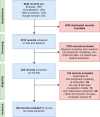Use of unstructured text in prognostic clinical prediction models: a systematic review
- PMID: 35475536
- PMCID: PMC9196702
- DOI: 10.1093/jamia/ocac058
Use of unstructured text in prognostic clinical prediction models: a systematic review
Abstract
Objective: This systematic review aims to assess how information from unstructured text is used to develop and validate clinical prognostic prediction models. We summarize the prediction problems and methodological landscape and determine whether using text data in addition to more commonly used structured data improves the prediction performance.
Materials and methods: We searched Embase, MEDLINE, Web of Science, and Google Scholar to identify studies that developed prognostic prediction models using information extracted from unstructured text in a data-driven manner, published in the period from January 2005 to March 2021. Data items were extracted, analyzed, and a meta-analysis of the model performance was carried out to assess the added value of text to structured-data models.
Results: We identified 126 studies that described 145 clinical prediction problems. Combining text and structured data improved model performance, compared with using only text or only structured data. In these studies, a wide variety of dense and sparse numeric text representations were combined with both deep learning and more traditional machine learning methods. External validation, public availability, and attention for the explainability of the developed models were limited.
Conclusion: The use of unstructured text in the development of prognostic prediction models has been found beneficial in addition to structured data in most studies. The text data are source of valuable information for prediction model development and should not be neglected. We suggest a future focus on explainability and external validation of the developed models, promoting robust and trustworthy prediction models in clinical practice.
Keywords: clinical prediction model; electronic health records; machine learning; natural language processing; prognostic prediction.
© The Author(s) 2022. Published by Oxford University Press on behalf of the American Medical Informatics Association.
Figures







